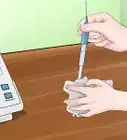This article was co-authored by Doug Ludemann. Doug Ludemann is the owner and operator of Fish Geeks, LLC, an aquarium services company based in Minneapolis, Minnesota. Doug has worked in the aquarium and fish-care industry for over 20 years, including having worked as a professional aquarist for the Minnesota Zoo and Shedd Aquarium in Chicago. He received his Bachelor of Science in Ecology, Evolution, and Behavior from the University of Minnesota.
This article has been viewed 46,498 times.
When thinking of "aquariums" full of freshwater, it’s hard to not think of little fish swimming around. There are tanks, however, made just for freshwater plantings! Maintenance is easy, but don’t skimp. While it may not seem as fun at first, it is an exciting hobby to get into. Aquascaping (arranging aquatic plants) is a true art form and there are contests for who can create the best underwater scene! This is a unique way to keep plants, arguably the best way, so read on to find out how.
Steps
Setting Up Tank Necessities
-
1Purchase and set up all necessary equipment. Just because you don’t have any fish doesn't mean you can skimp on the basics,[1] including:
- A simple filter of your choosing (hang-on back filters are the easiest to find and are suitable for most tanks),
- A tank light for growing plants, secured properly for safety. Different plants need different light levels, so do research and plan your tank accordingly.
- An air pump (with airstones and airline tubing). It does not need to be strong, but needs to disturb the water and add oxygen to prevent stagnant water buildup.
- If your tank’s water temperature reaches cool extremes, it’s best to invest in a heater as well.
- Sunlight is not a suitable replacement for tank lights! It can heat up the tank; it's unregulated, and accelerates algae growth, so keep your tank away from it.
-
2Add gravel, sand, or other plant-friendly substrates and decorations as needed. Wash such material with normal tap water, thoroughly.
- You can skip decorations, but substrate is vital in planted tanks. Keep in mind that certain plants do better with certain substrates.
Advertisement -
3Add conditioned water. Use a proper water conditioner to prepare; don't just aerate the water. You might also add aquarium salt (1 tbsp per 5 US gallons) to ward off unsightly parasites, but aquatic plants usually don’t have many parasitic animals plaguing them. But if you add invertebrates, then do add sea salt for them.
- Don’t, as yet, add the plant fertilizer (substrate or water soluble).
-
4Cycle your tank. You must not skip this even if you only want plants. Plants die over time, and a proper bacterial filtration system will make sure ammonia, nitrites, and nitrates don’t skyrocket.
- While some (not a lot!) of nitrates are vital to the plants’ growth -- ammonia and nitrites are toxic to them. Plants handle the chemicals better than fish do, but it’s better to err on the caution side.[2]
Dealing With The Plants
-
1Research your desired plants’ requirements. Of course, buy freshwater plants. As mentioned before, light requirements are a big factor. If your light is not strong enough (or too strong),[3] then revise your plans. Think about nutritional requirements and how each plant grows. Larger plants shade over others if not arranged properly, blocking out light. All of the plants need to coexist peacefully.
- Buy from reputable sites. A snail-free promise should be searched for, as snails can reproduce quickly to decimate your tank.
- Research carefully. Some “aquatic” plants actually should not be fully submerged. It’s great to use these, but don’t put them fully in the water.[4] They will rot.
- Many plants are fine with gravel, but some do poorly in sand. Keep this in mind.
-
2Plan the plants’ positions aesthetically. This is the artsy part of aquascaping. Tall, bushy plants should be near the back to provide a background. Shorter, weedier plants can be in the middle. Smaller, stunningly beautiful plants can be in the front as a centerpiece. Put the airstone in between plants to hide it, if you want. Try to use your imagination to build underwater scenes that have a natural feel to them.
- If you included natural wood décor, there are “mosses” or other plants that flourish on floating wood. Add them to the wood!
- A good example would be an underwater “meadow”. Hairgrass, wood, and rocks are used to create the illusion of a scene usually seen on ground.
-
3Add nutritional supplements if needed. There are different forms of nutrients, from pellets to solutions. Add the right amount according to your tank and follow instructions to the T. Since there are no fish (even if you will add invertebrates), there will be minimal waste for the plants to utilize. This is key to a healthy tank.
- Follow suppliers' instructions. Don’t just put in whatever seems reasonable. Too much can burn the roots and plants or mess up water chemistry.
-
4Add the plants. Rinse off debris with normal tap water and snip off any yellow or dead parts. Hopefully, you’ve devised a plan on how to arrange them by size and kinds, so work logically. Some plants have a rhizome similar to roots -- but some of those should not be buried, so be careful to read each of their requirements.
- Plants that grow on wood can be tucked into crevices or held in place gently by a temporary, weak rubber band.
- Rooted plants should have their roots tucked completely into the substrate.
- Floating plants can be anchored to aquarium weights or rocks, or left to freely wander.
Performing Maintenance
-
1Check and modify the water every two weeks or so. Even if less waste is being produced than in a fish tank, the nitrates will eventually build up. Depending on whether you put special invertebrates in (see “Adding Invertebrates”) depending on your tank size, and your number of plants, this frequency will change. This is a general rule. Replace 25% of the water, correctly treated and with aquarium/sea salt for health of freshwater fish if you want.
- Once in a while, use your gravel or substrate vacuum to clean the substrate surface of rotting organic matter.
EXPERT TIPDoug Ludemann is the owner and operator of Fish Geeks, LLC, an aquarium services company based in Minneapolis, Minnesota. Doug has worked in the aquarium and fish-care industry for over 20 years, including having worked as a professional aquarist for the Minnesota Zoo and Shedd Aquarium in Chicago. He received his Bachelor of Science in Ecology, Evolution, and Behavior from the University of Minnesota.Professional Aquarist
 Doug Ludemann
Doug Ludemann
Professional AquaristMonitor your tank's pH level to keep it just below 7.0. Plants have a preference for ammonium, which is present in a slightly acidic environment, which occurs at a pH below 7.0. In an alkaline environment, or anything above 7.0, ammonium becomes ammonia, which is bad for your plants.
-
2Top off your tank as needed. If you use salt as an electrolyte or supplement for aquatic health, do not add salt to the water when you are only topping it off! When water evaporates from your tank, the salt does not evaporate with it. Adding more salt can make the tank too salty. As always, condition the water.
-
3Add fertilizers if needed. Some substrate fertilizers last for a very long time and do not need to be bothered for months. Some liquid varieties require weekly additions, so make sure you keep up on that. A carbon dioxide supplement (recalling that plants make and give off oxygen but need carbon dioxide given off by fish and other animals) can be useful as well, added weekly, and does not harm any animal or plant if used with the correct proportions.[5]
-
4Scrubbing off algae may need to be done once in a while to keep up the appearance. Algae is not harmful unless it starts to block out light and suck up too many nutrients. A soft-padded brush (available at pet stores) easily gets the job done. Algae on plants is usually fine. If it bothers you, lightly rub it off with your fingers.
- Avoid too much algae by keeping the tank away from sun, not using too-strong lights, and not overdoing fertilizer/supplements.
Adding Invertebrates (Optional)
-
1Like with getting any new pet, research on what is acceptable for your current tank. These should be added to an established planted tank. Common invertebrates such as mystery snails and shrimp actually function as tank “cleaners”, eating waste, dead matter. Many species are peaceful, but some can be incredibly aggressive. Some prefer open space, while others prefer hiding spaces. Be mindful.
- Most pet store variety invertebrates only eat dead matter, but some do eat live plants. Furnishing their needs and protecting your aquatic plants can include putting in bits of plant material.
-
2Pick healthy specimens. Bright colors (if applicable), active movements, and an intact body indicate good health.[6] Ask the pet supplier about the conditioning of their invertebrates tanks to get a sense of how they are handled by them. If you see a tank with dead or diseased organisms (even fish), it may be best to pass on the invertebrates in there.
- Don’t be afraid to request particular sizes and kinds of specimens! This is common and acceptable.
- Avoid buying baby invertebrates for an unestablished tank. They generally do not do well in a newly prepared tank.
-
3Add them in slowly and acclimate them. You should not add more than a few of any animal in at one time, to let the tank get used to it. Adding them in means that you should put them in a bucket of your tank water and gently scoop them out of the bag of store water. Dumping the bag’s contents into your tank can stress them and introduce questionable pet-store water into your water.
- The best method to acclimate them is to simply float the animals’ bag in the tank water for at least 30 minutes.
-
4Feed them properly. Giving them debris from cleaning a fish tank does not provide enough food for invertebrates. Giving them a balanced diet of bits of vegetables, pellets, or frozen foods ensures healthiness. You want to make your invertebrates part of the whole underwater scene, not just a side attraction. Feed them well and they will grow beautifully!
- Inadequate feeding of vegetable food will push normal scavengers into eating your plants at times, so protect your plants by feeding adequately.
- Remove food after a few hours/within the day if not eaten, to prevent mold/algae.
-
5Enjoy the sight of your creatures among your nice plants! Shrimp can enhance visual appeal of the tank, while tidying it. This type of tank can sustain/clean itself nicely, with animals and plants working together. Still, take care of your tank!
Expert Q&A
Did you know you can get expert answers for this article?
Unlock expert answers by supporting wikiHow
-
QuestionWhy are my plants dying in the aquarium?
 Doug LudemannDoug Ludemann is the owner and operator of Fish Geeks, LLC, an aquarium services company based in Minneapolis, Minnesota. Doug has worked in the aquarium and fish-care industry for over 20 years, including having worked as a professional aquarist for the Minnesota Zoo and Shedd Aquarium in Chicago. He received his Bachelor of Science in Ecology, Evolution, and Behavior from the University of Minnesota.
Doug LudemannDoug Ludemann is the owner and operator of Fish Geeks, LLC, an aquarium services company based in Minneapolis, Minnesota. Doug has worked in the aquarium and fish-care industry for over 20 years, including having worked as a professional aquarist for the Minnesota Zoo and Shedd Aquarium in Chicago. He received his Bachelor of Science in Ecology, Evolution, and Behavior from the University of Minnesota.
Professional Aquarist The pH level of the water may be off. I would monitor the pH level to keep it just below 7.0. Plants have a preference for ammonium, which is present in a slightly acidic environment, which occurs at a pH below 7.0. In an alkaline environment or anything above 7.0, ammonium becomes ammonia, which is bad for your plants.
The pH level of the water may be off. I would monitor the pH level to keep it just below 7.0. Plants have a preference for ammonium, which is present in a slightly acidic environment, which occurs at a pH below 7.0. In an alkaline environment or anything above 7.0, ammonium becomes ammonia, which is bad for your plants.
Warnings
- Avoid stirring up the substrate a lot if you use pellet fertilizer.⧼thumbs_response⧽
- Don’t uproot your plants for a cleaning; it’s not necessary and can be harmful to the plant’s growth.⧼thumbs_response⧽
- Never do a full water change unless your tank presents a real reason.⧼thumbs_response⧽
- Changing your whole filter cartridge and media (where most of the nitrifying bacteria reside) should not be done. You can take out the media (usually charcoal substance inside the cartridge) and transfer it into another cartridge if needed.⧼thumbs_response⧽
- Never wash a filter cartridge with bacteria from a cycle in tap water. This will kill the bacteria.⧼thumbs_response⧽
- Invertebrates can’t completely fill in for you; you will need to perform actual cleaning duties!⧼thumbs_response⧽
Things You’ll Need
- Gravel siphon or turkey baster
- Bucket
- Scrubbing pad or tool
- Water conditioner
- Aquarium salt (optional)
- Aquatic plant fertilizers and/or supplements
- Freshwater aquatic plants
- Substrate
- Fish tank
- Tank light
- Filter
- Heater (optional)
- Air pump, tubing, and stone
References
- ↑ https://users.cs.duke.edu/~narten/faq/hardware.html
- ↑ https://m.liveaquaria.com/article/62/?aid=62
- ↑ https://www.tropicalfishcareguides.com/aquarium-led-lighting/led-aquarium-lighting-how-much-led-light-for-a-planted-aquarium/
- ↑ https://modestfish.com/best-beginner-aquarium-plants/
- ↑ https://www.aquariumcoop.com/blogs/aquarium/which-aquatic-fertilizer-is-right-for-you
- ↑ https://www.bluezooaquatics.com/resources.asp?show=21
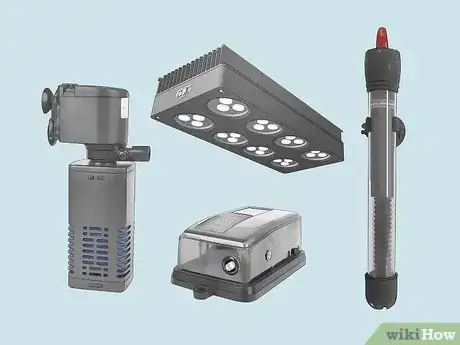
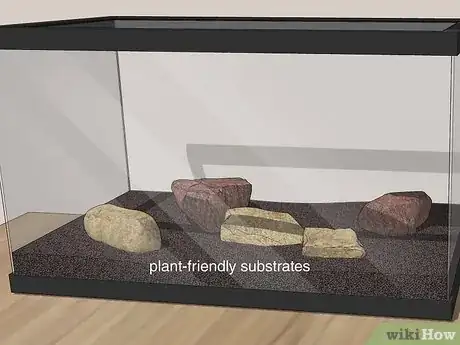
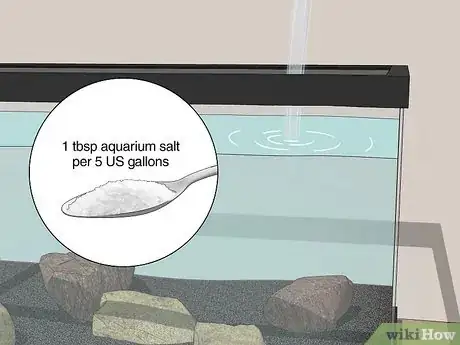
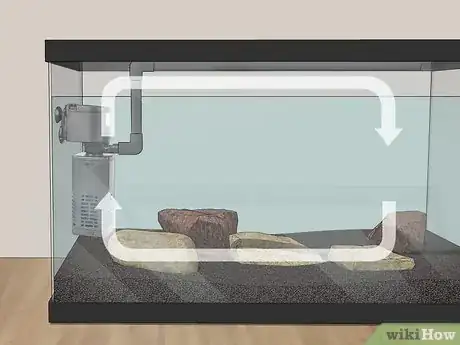
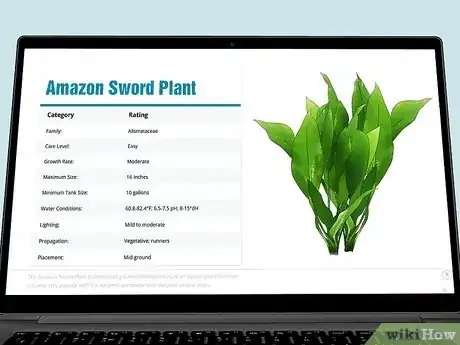
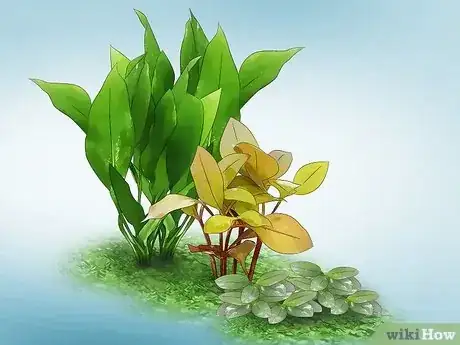

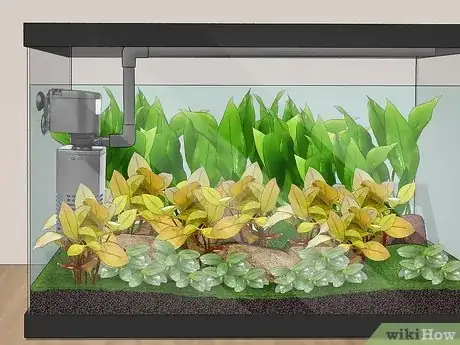
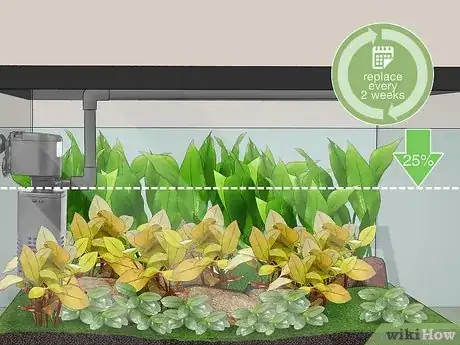
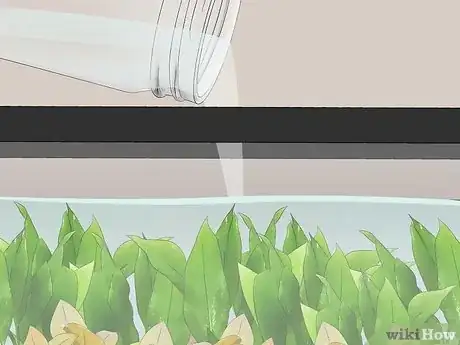
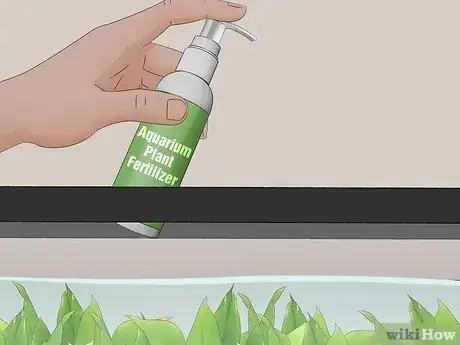
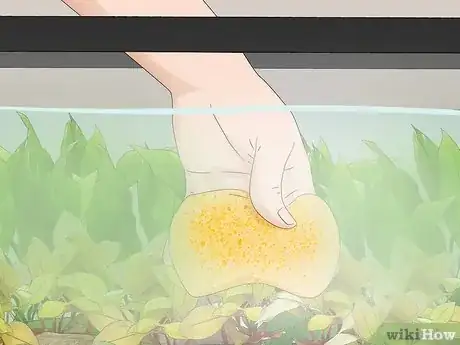
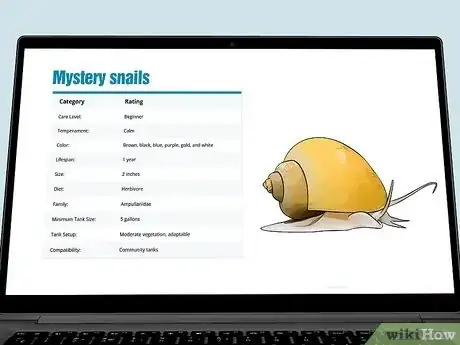
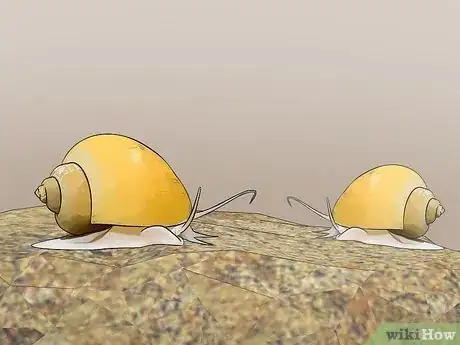

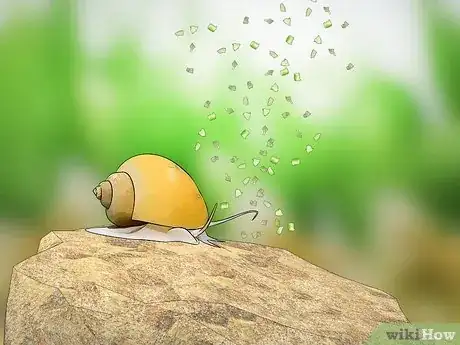
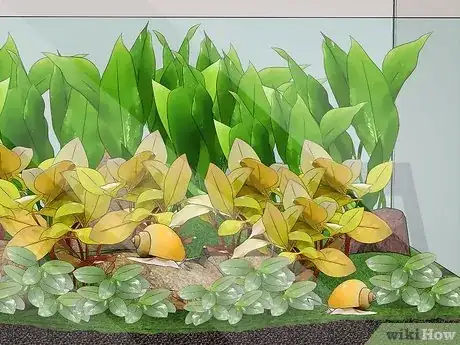
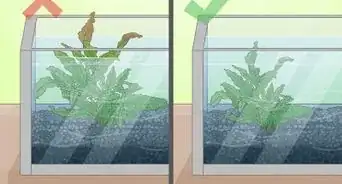
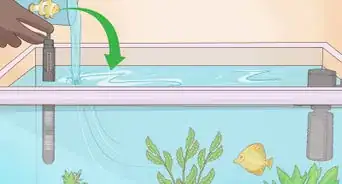
-Step-10-Version-2.webp)



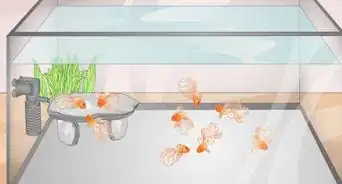
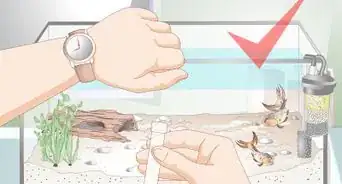
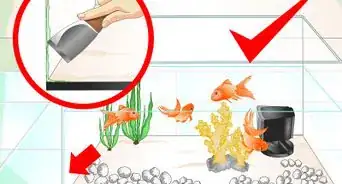


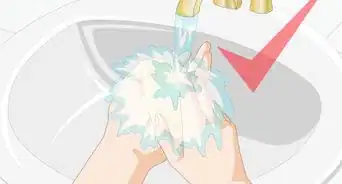









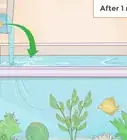
-Step-10-Version-2.webp)
